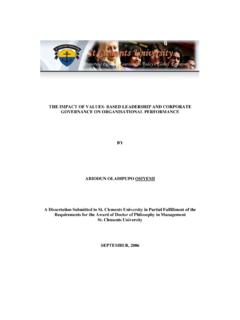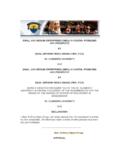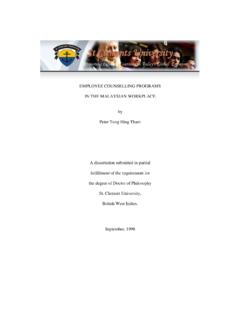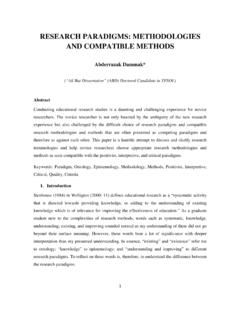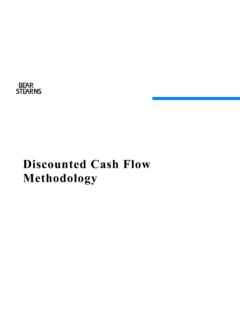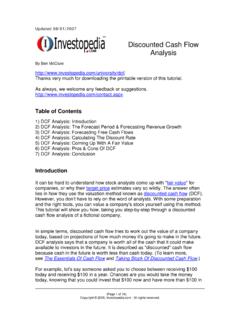Transcription of An analysis of discounted cash flow (DCF) approach to ...
1 An analysis of discounted cash flow (DCF) approach to business valuation in Sri Lanka by Thavamani Thevy Arumugam Matriculation Number: 8029 This dissertation submitted to St Clements University as a requirement for the award of the degree of Doctor of Philosophy in Financial Management September 2007 Table of Contents Chapter 1 wealth Concept of an Future/Present value of discounted cash flow (DCF)..8 History of discounted cash flow (DCF).
2 9 Risk in Valuation of a Problem Why do these valuations differ?..13 How does one know which of these values is the most accurate?..13 Previous research and potential Industry and economic Chapter 2 Literature The investment Risk attitude and Fundamentals of risk An approach to risk Why is business valuation important?..27 Valuation Asset based Value of Absolute valuation or discounted cash flow (DCF) Incorporate financial and non-financial performance Free cash flow (FCF) discount Calculating the terminal Calculating the discount Country risk and cost of Calculating total enterprise value (EV).
3 54 Calculating the value of equity (Ve)..55 How do the analysts value a business that is losing money?..55 Pros and cons of discounted cash flow discounted dividend Relative First principles:..60 What is relative valuation?..62 Reasons for Potential Reconciling relative and discounted cash flow Chapter 3 Method Inductive or deductive Quantitative and qualitative Research Research Data collection Modes of data Advantages of Disadvantages of Deductive After the interviews, the following steps were taken:..71 Reliability and validity of the Statement of Statistical techniques used in the Chapter 4 Results and Descriptions of Participants Valuation SWOT Financial Terminal Cost of Risk free Risk Beta Cost of Discount Responses to open Inferential Tables 1 (r) to v (r).
4 97 analysis of Risk and Valuation of businesses under Adapting discounted cash flow valuation to distress situations114 Valuing high growth Chapter 5 Recommendations and Further Chapter 1 Introduction Background Financial management is broadly concerned with the acquisition and use of funds by a firm. Corporate finance theory has developed around a goal of shareholder wealth maximization. Evolution of the corporate financial objective: Until 1921, the firms did not see any need for stating financial objectives. The corporate financial objective since then has grown into three phases.
5 Profit maximization objective Social responsibility of business Shareholder wealth maximization During the time of debate on the social responsibility of business, a few researchers and thinkers put forward various arguments. That was essentially a struggle for developing a more acceptable objective statement with time; shareholder wealth maximization and shareholder value became universally accepted financial statements for businesses. Wealth maximization The debate around profit maximization and social responsibility led to finding a more logical expression of corporate objectives. This pursuit led to the theory of shareholder wealth maximization.
6 David Durand and Lutz (1952) introduced the concept of shareholder wealth maximization. They observed that the goals of profit maximization as well as wealth maximization are consistent with each other only under two conditions: (1) Investment takes place in tiny increments and (2) Where there is certainty in getting the return on investment The wealth maximization goal is based on discounting, while putting forth is macro-economic theory of interest introduced by Alfred Marshall in 1930. Keynes used the discounting factor in 1936 in his concept of marginal efficiency of capital. The shareholders wealth maximization goal, thus, reflects the magnitude, timing and risk associated with the cash flows expected to be received in the future by shareholders.
7 Concept of an investment An investment is the outlay of a sum of money in the expectation of a future return. This compensates for the original outlay as well as to cover the inflation, interest foregone and risk. An investment today will determine the firm s strategic position many years hence. Capital budgeting is primarily concerned with sizable investments in long-term assets. These assets may be tangible items such as property, plant & machinery or intangible ones such as new technology, patents or trademarks. Investments in processes such as research, design, development and testing through which new technology and new products are created may also be viewed as investments in intangible assets.
8 Firms operate in a dynamic environment therefore; they must continually make changes in different areas of their operations in order to meet the challenges of the changing environment. The strategic need of the firm will determine amongst other things which investment meet the strategic objectivity. By analysing the strengths, weaknesses, opportunities and threats (SWOT) of the firm and external factors such as political, economical, social and technological (PEST) affecting the firm the management will be able to come to an optimal decision. The net benefits of investment depend upon the quality of investment decisions.
9 The quality is judged through the weighing of benefits against the risks and uncertainties. The net benefit of the project will be a function of (a) The risks involved (b) the ability to generate synergy, and (c) the firm s internal control and pro-activeness. Future/Present value of money Investment, financing and dividend decisions have significant impact on the firm s valuation. A key concept underlying valuation is the value of money based on time. Money has time value. An investment of one rupee today would grow to (1+r) a year hence. (r is the rate of return earned on the investment) In an inflationary period, a rupee today represents a greater real purchasing power than a rupee a year hence.
10 This is due to opportunity cost and risk over time. Many financial problems involve cash flows occurring at different points of time. For evaluating such cash flows , an explicit consideration of time value of money is required. The value of the present investment on a future date to the time value of money is called the future value of money. The concept of discounting is the reverse of compounding; using the compounding process, the future value of today s money can be found at a given rate of interest. By discounting, the present value of a future cash flow can be found. The formula for discounting can be obtained by interchanging the sides of the compounding formula.


